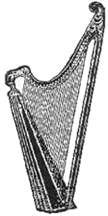|
             
Copyright
Helen Forder
2004
|
|
The
Harp, by Brinley Richards ...
continued
|
page 2
|
|
The purpose of this paper,
however, is to attempt a sketch of the harp in its national and historical aspect,
rather than in reference to its music; for it is probable that all stringed
instruments which have not the means of sustaining sounds like a violin,
must in time give place to others more in accordance with the requirements
of modern art; and, considering the immense changes that have taken place
in the construction of instruments, it is not altogether improbable that
even the pianoforte and the harp will at some future period be considered
of little value except as curiosities of ancient art.
|

|
|
Harps of some kind appear to
have been known to most nations, even to the Saxons and the Danes, as well
as to the Irish, the Scotch, and the Welsh. There are ample proofs of the
popularity of the harp; and that the art of playing it was cultivated by
persons of the highest rank. This is placed beyond doubt by many historical
facts. When King Alfred reconnoitred the Danish encampments in 875, he was
disguised as a minstrel; and the same thing occurred many years later when
the Danish King, Aulaff, explored the camp of Athelstan. It is related that
he took his harp among the Saxons, and played with such skill, that he was
at once admitted to the Royal pavilion. From this, it is evident that the
harp at that time was small and of light weight, as it was so easily
carried about by the player. In attempting to sketch the history of such an
ancient instrument, it is difficult to discover what was meant by the term
"harp", since it was used to describe all kinds of instruments,
however unlike they may have been to our own, except that the sounds were
produced by means of strings formed of sinews, silk, hair, or wire. It is
evident that the ancient Gauls and Britons were familiar with the harp; but
whether this was the identical instrument which has since been recognised
under the appellation of the 'harp', it is impossible to say.
|
|
Diodorus Siculus (who lived
in the time of the Caesars, Julius and Augustus) informs us "that the Gauls had amongst them composers of
melodies whom they called bards, and that they sung to instruments like
lyres". Vague as is the expression "instruments like lyres", yet, when in conjunction with it a few hundred
years afterwards, we find the harp in the hands of their Celtic successors,
the bards of Wales, Ireland, and Scotland, we see that the harp, rude in
construction and with few strings, was probably the instrument spoken of by
Diodorus. If it be true, that the Welsh, Irish, and Scotch people all
descend from one Celtic origin, it may account for the fact that the harp
was familiar to each nation.
|
|
back 1 2 3 4 5 6 7 8 next
|
|